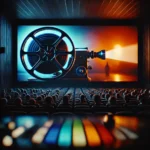Film music is more than just a background element; it’s a critical tool for enhancing emotional depth, guiding audience reactions, and defining cinematic moments. Whether it’s a soaring symphony accompanying a triumphant hero or a subtle melody signaling an intimate scene, music has the power to transform the narrative.
In this article, we’ll explore the ways film scores contribute to storytelling, including how they shape emotion, define character arcs, and support the overall atmosphere of a film. Through examples from famous movies, we’ll demonstrate the pivotal role music plays in making films memorable and immersive.
The Role of Music in Setting the Mood
One of the primary functions of a film score is to set the tone and mood of a scene. Directors and composers collaborate to ensure that the music matches the emotional context, whether it’s creating tension in a thriller, adding warmth to a family drama, or evoking wonder in a fantasy epic.
For example, in “Jaws” (1975), John Williams used an iconic, minimalist two-note motif to build suspense and dread, preparing the audience for the shark’s arrival. The power of this score lies in its simplicity—it intensifies fear even when the shark is off-screen. Similarly, in “Inception” (2010), Hans Zimmer’s deep, reverberating score plays a key role in amplifying the movie’s complex, dream-like atmosphere.
Music helps audiences subconsciously connect to the themes of a film, guiding them through shifts in tone and pace. Without music, many scenes would feel flat or incomplete, as it anchors the viewer’s emotional experience.
Building Emotional Connections
Music has the ability to evoke emotions that words and visuals alone cannot fully capture. A well-composed score can elicit joy, sadness, excitement, or fear, often intensifying the emotional response to pivotal moments in a film.
Take “The Lion King” (1994) as an example. Hans Zimmer’s score, combined with Elton John’s songs, captures both the grandeur and intimacy of the African savannah. The use of music in the “Circle of Life” scene heightens the audience’s sense of awe and wonder at the birth of Simba, while the sorrowful melody accompanying Mufasa’s death helps emphasize the tragedy of the moment.
In romantic films like “La La Land” (2016), Justin Hurwitz’s jazz-infused score plays a major role in illustrating the journey of the characters’ love and aspirations. The recurring musical themes connect viewers with the protagonists’ emotional highs and lows, making their experiences more relatable and impactful.
Defining Character Themes
Another powerful tool in film scoring is the use of leitmotifs—short, recurring musical phrases associated with specific characters, places, or ideas. This technique helps audiences associate certain emotions or characteristics with individuals in the film, adding a layer of meaning to the narrative.
In “Star Wars” (1977), John Williams employs leitmotifs masterfully, giving each character or faction a distinct musical identity. The “Imperial March” is instantly recognizable as the theme for Darth Vader and the Galactic Empire, while the hopeful “Force Theme” reflects the spiritual journey of the Jedi. These motifs help create continuity across the saga, reinforcing the characters’ arcs and their roles in the broader narrative.
Leitmotifs can also evolve as characters develop. For example, in “The Lord of the Rings” trilogy, Howard Shore’s score adjusts the familiar themes for Frodo and the Fellowship, reflecting the transformation of the characters and the stakes of their journey.
Enhancing Pacing and Tension
Music plays a vital role in controlling the pacing of a film. Composers can manipulate rhythm, tempo, and volume to build tension or release it at key moments, influencing the audience’s perception of time and urgency.
In “Dunkirk” (2017), Hans Zimmer uses a ticking clock motif and increasing tempo to heighten the sense of urgency and desperation felt by the characters during the evacuation. The music intensifies the audience’s anxiety, making every second feel more critical.
Similarly, in horror films like “Psycho” (1960), Bernard Herrmann’s screeching violins during the infamous shower scene are essential to building the tension and terror of the moment. The music, synced perfectly with the visual action, adds a visceral layer of fear to the scene that wouldn’t be as effective without it.
Film scores are more than just an accessory to the visuals; they are integral to the storytelling process. Through careful composition and strategic placement, music enhances mood, reinforces character development, and manipulates the pace of a narrative. The next time you watch a film, pay close attention to the score and consider how it shapes your emotional response and connection to the story.
By understanding the power of film music, audiences can gain a deeper appreciation for how sound and story intertwine to create unforgettable cinematic experiences.


